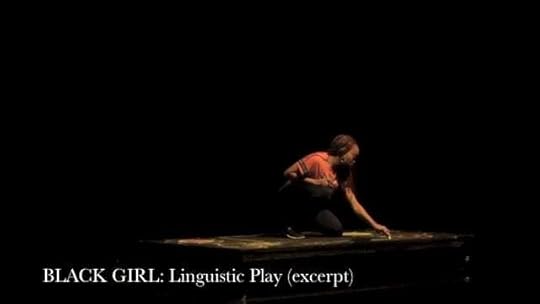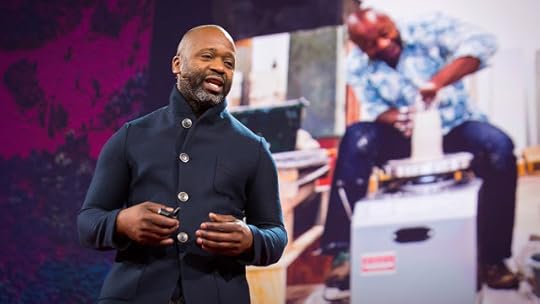Mark Anthony Neal's Blog, page 712
July 27, 2015
When Even a Hologram of a Black Male is Deemed a Threat
 'Rapper Chief Keef has a warrant out for his arrest in Illinois and Indiana, so he decided to perform in a concert via hologram. The police didn't find that too amusing, so they shut the whole concert down.'-- via +AJ+
'Rapper Chief Keef has a warrant out for his arrest in Illinois and Indiana, so he decided to perform in a concert via hologram. The police didn't find that too amusing, so they shut the whole concert down.'-- via +AJ+
Published on July 27, 2015 13:39
Call the Law: Before and After the Call & Response--on Black Artfulness and Survival
 Duke University's I. Augustus Durham presents “Call the Law: Before and After the Call and Response or The Sojourn to the Truth" at the
Resisting Arrest: Black Artfulness and Survival: A One Day Symposium on Art and Resistance
Symposium.
Duke University's I. Augustus Durham presents “Call the Law: Before and After the Call and Response or The Sojourn to the Truth" at the
Resisting Arrest: Black Artfulness and Survival: A One Day Symposium on Art and Resistance
Symposium.
Published on July 27, 2015 13:20
Before #BlackTwitter: The Stoop and Desire for Public/Private Space
 Before #BlackTwitter: The Stoop and Desire for Public/Private Spaceby Mark Anthony Neal | @NewBlackMan | NewBlackMan (in Exile)
Before #BlackTwitter: The Stoop and Desire for Public/Private Spaceby Mark Anthony Neal | @NewBlackMan | NewBlackMan (in Exile)That it was another place and time, is hardly the matter. It was my world--a two-mile radius that would take you from 168th Street and Third Avenue; Forest Avenue and 166th Street; that intersection of Boston Road (we never called it Boston Post Road in the Bronx) and 168th Street, and St. John’s Church on Fulton Avenue (where the Head Start was housed). If 1231 Fulton Avenue, nestled between 168th and 1969th Streets, and across the street from Bronx Lebanon Hospital was the epicenter of my life, the stoop of that address, was the epicenter of that building.
Years before I knew who Jurgen Habermas was, or was introduced to the concept of a Black public sphere, or could wrap my head around a global Black Diaspora connected across a micro-blogging platform called Twitter, the very spirit of #BlackTwitter could be found on that stoop, in front of 1231 Fulton Avenue, and many such stoops across Black America.
The “Stoop” and its country (not necessarily Southern) cousin the “Porch” was evoked in an article in The Atlantic, which talks about two museums projects--a planned expansion of the Studio Museum in Harlem and the National Museum of African-American History and Culture (NMAAHC), which opens in Washington, D.C. next year--that utilize elements of both as a design features.
Architect David Adjaye, who along with Phil Freelon designed the NMAAHC, and is the primary designer on the Studio Museum project, explained to the New York Times that he wanted to “honor this idea of public rooms, which are soaring, celebratory and edifying...between the residential and the civic, we learned the lessons of of public realms and tried to bring them together.”
The “porch” that will greet visitors at the NMAAHC and the “reverse stoop” planned for the Studio Museum are less about nostalgia, but the continuous desire of Blacks in America to cultivate a private/public space, outside of the home, but away from the scan on the mainstream. In this regard, #BlackTwitter is still trying to find consistent digital strategies, for the “analog” examples that the “Stoop” and “Porch” represented, though, of course the “Stoop” and “Porch” never had the reach of #BlackTwitter--even conceptually.
As a little boy, me and the JA-merican Princess-turned Hip-Hop Feminist icon--spent many an afternoon dreaming of places that our words would conjure a generation later. My favorite memories though are of summer evenings circa 1974-1975, where it seemed the whole building set up shop--with picnic chairs and card tables, that extended beyond both sides of the “Stoop”.
My mother, as a Baltimore girl, with that city’s own landscape of row houses with stoops, found a second home on that 1231 “Stoop.” We’d often wait outside until my father got home, usually after 10pm, from his short-order cook gig in Brooklyn, usually bearing treats--the orange Hostess cupcakes for me, a pack of Winston’s for my mom--from the Bodega down the block.
While I was busy playing ghetto games like “Red Light, Green Light” and Freeze Tag--and sneaking glances at no longer prepubescent Black girls doing Double-dutch--the adults, with smatterings patois, Spanglish, and down-home speak, could be heard in the background discussing everything from the frayed marriage of Bill Withers and actress Denise Nicholas (where I first heard of the singer’s purported abuse), Richard Nixon’s resignation in 1974, the financial crisis and national recession that put New York City on the brink of default, the genius of Muhammad Ali and whether Jermaine Jackson was really leaving the Jackson 5.
Those were the last summers that I spent at 1231 Fulton Avenue--the very financial struggles that working class families were experiencing throughout New York City drove my family into the projects, and while there were courtyards and other public spaces set-up in our neighborhood--and often to aid in the surveillance of the neighborhood--the kind of vibrant community that I experienced on the stoop was largely lost to me, until the advent of social media platforms like Facebook and Twitter.
Much thanks given to #BlackLivesMatter for making #BlackTwitter a thing, but Black Lives Mattered on those stoops, a reminder, perhaps, that even if the technology might be brand new, our humanity and need for connection, ain’t.
***
Mark Anthony Neal is Professor of African & African American Studies at Duke University, where he also directs the Center for Arts, Digital Culture and Entrepreneurship. Neal is the author of five books and is currently researching his next project Big Black Data: from Analog to Digital Blackness.
Published on July 27, 2015 12:20
July 25, 2015
Camille A. Brown with Tracy Wormworth in BLACK GIRL: Linguistic Play (excerpt)
 BLACK GIRL: Linguistic Play reveals the complexity of carving out a self-defined identity as a Black female in urban American culture. In a society where Black women are often only portrayed in terms of their strength, resiliency, or trauma, this work seeks to interrogate these narratives by representing a nuanced spectrum of Black womanhood in a racially and politically charged world. With original music compositions (live music by pianist, Scott Patterson and electric bassist, Tracy Wormworth), Camille A. Brown uses the rhythmic play of African-American dance vernacular including social dancing, double dutch, steppin’, tap, Juba, ring shout, and gesture as the Black woman’s domain to evoke childhood memories of self-discovery. World Premiere performances of BLACK GIRL: Linguistic Play begin on September 22, 2015 at the Joyce Theater.
BLACK GIRL: Linguistic Play reveals the complexity of carving out a self-defined identity as a Black female in urban American culture. In a society where Black women are often only portrayed in terms of their strength, resiliency, or trauma, this work seeks to interrogate these narratives by representing a nuanced spectrum of Black womanhood in a racially and politically charged world. With original music compositions (live music by pianist, Scott Patterson and electric bassist, Tracy Wormworth), Camille A. Brown uses the rhythmic play of African-American dance vernacular including social dancing, double dutch, steppin’, tap, Juba, ring shout, and gesture as the Black woman’s domain to evoke childhood memories of self-discovery. World Premiere performances of BLACK GIRL: Linguistic Play begin on September 22, 2015 at the Joyce Theater.Camille A. Brown with Tracy Wormworth in BLACK GIRL: Linguistic Play (excerpt) from Camille A. Brown & Dancers on Vimeo.
Published on July 25, 2015 20:27
David Adjaye--'Collaborations' with Lorna Simpson (dir. Oliver Hardt)
 Collaborations is the second documentary film by director Oliver Hardt on the work of British-Ghanaian architect David Adjaye. The film features interviews with Adjaye’s collaborators, a roster of influential figures in the art and cultural world, and examines a significant number of his architectural projects, including public buildings, residential houses, artist studios and exhibition spaces globally situated and developed over the past fifteen years. In this clip artist Lorna Simpson leads viewers of a tour of the Brooklyn Studio that Adjaye designed with the artist.
Collaborations is the second documentary film by director Oliver Hardt on the work of British-Ghanaian architect David Adjaye. The film features interviews with Adjaye’s collaborators, a roster of influential figures in the art and cultural world, and examines a significant number of his architectural projects, including public buildings, residential houses, artist studios and exhibition spaces globally situated and developed over the past fifteen years. In this clip artist Lorna Simpson leads viewers of a tour of the Brooklyn Studio that Adjaye designed with the artist. DAVID ADJAYE – COLLABORATIONS: PITCH BLACK featuring Lorna Simpson from Signature Films, Germany on Vimeo.
Published on July 25, 2015 20:13
Cassandra Wilson--"Don't Explain" (from 'Coming Forth By Day')
 Music and Visuals for "Don't Explain"-- a Cassandra Wilson cover of the Billie Holiday classic, which appears on Coming Forth by Day.
Music and Visuals for "Don't Explain"-- a Cassandra Wilson cover of the Billie Holiday classic, which appears on Coming Forth by Day.
Published on July 25, 2015 20:05
Ta-Nehisi Coates: "We accept violence against African-Americans as normal"
 In his new book, Between the World and Me, Atlantic magazine columnist Ta-Nehisi Coates writes about the looming violence that African-Americans endure every day, in the form of a letter to his 14-year-old son. PBS NewsHour's Hari Sreenivasan speaks with Coates about the legacy of racism and White supremacy in America.
In his new book, Between the World and Me, Atlantic magazine columnist Ta-Nehisi Coates writes about the looming violence that African-Americans endure every day, in the form of a letter to his 14-year-old son. PBS NewsHour's Hari Sreenivasan speaks with Coates about the legacy of racism and White supremacy in America.
Published on July 25, 2015 13:58
'Gig-Economy'--Freelance Employment--Trending Upward for Millennials and Companies
 Al Jazeera America's Michael Shure takes a look how the business of freelance jobs--the "Gig Economy"-- is booming in some sectors.
Al Jazeera America's Michael Shure takes a look how the business of freelance jobs--the "Gig Economy"-- is booming in some sectors.
Published on July 25, 2015 13:46
Artist Theaster Gates on How to Revive a Neighborhood: with Imagination + Beauty + Art
 'Theaster Gates, a potter by training and a social activist by calling, wanted to do something about the sorry state of his neighborhood on the south side of Chicago. So he did, transforming abandoned buildings to create community hubs that connect and inspire those who still live there (and draw in those who don't). Gates describes his efforts to build a "miniature Versailles" in Chicago, and he shares his fervent belief that culture can be a catalyst for social transformation in any city.' -- TED
'Theaster Gates, a potter by training and a social activist by calling, wanted to do something about the sorry state of his neighborhood on the south side of Chicago. So he did, transforming abandoned buildings to create community hubs that connect and inspire those who still live there (and draw in those who don't). Gates describes his efforts to build a "miniature Versailles" in Chicago, and he shares his fervent belief that culture can be a catalyst for social transformation in any city.' -- TED
Published on July 25, 2015 10:08
Authorship, Authenticity & Gender in Hip-Hop: Jean Grae + Mark Anthony Neal on Huffpost Live
 In response to recent ghostwriting charges directed at Drake, Hip-Hop artist Jean Grae and Duke Professor Mark Anthony Neal discuss the gendered dynamics of perceptions of authorship and authenticity in Hip-Hop on Huffpost Live with Marc Lamont Hill.
In response to recent ghostwriting charges directed at Drake, Hip-Hop artist Jean Grae and Duke Professor Mark Anthony Neal discuss the gendered dynamics of perceptions of authorship and authenticity in Hip-Hop on Huffpost Live with Marc Lamont Hill.
Published on July 25, 2015 06:45
Mark Anthony Neal's Blog
- Mark Anthony Neal's profile
- 30 followers
Mark Anthony Neal isn't a Goodreads Author
(yet),
but they
do have a blog,
so here are some recent posts imported from
their feed.



